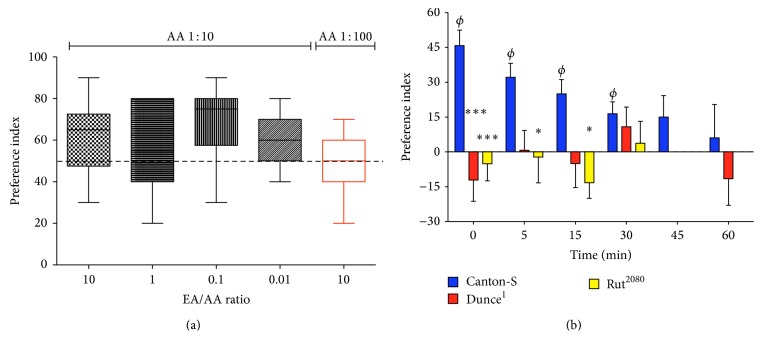Figure 2.
Establishing the conditions for larval aversive olfactory learning and memory. (a) Example of preference for AA over EA observed in larvae exposed to different ratios of EA/AA odorant dilutions. Odorant ratios induce a preference that is 60% or above, when the dilution of AA is set to 1 : 10 and the EA dilution is modified to obtain the indicated EA/AA dilution ratios (in black). On the other hand, when modifying the dilutions of both odorants to obtain an EA/AA ratio of 10 (in red), it leads to an equilibrated preference response (50% + 4.7%) that is different from the other dilutions shown. This data argues in favor of the idea that to control for responses to odorant dilutions is necessary for a balanced response of animals exposed to these stimuli. (b) Three training cycles induce a robust olfactory memory that lasts at least 30 min in larvae. Animals were subjected to a reciprocal training: larvae were exposed to one odorant in presence of salt and then to a second odorant that was not associated with salt. This training cycle was repeated two more times. Afterwards, animals were placed for 3 min in the test plate where the two odorants are present. The number of larvae in the conditioned and nonconditioned side of the chamber was recorded at different time points. Data show that control animals form an aversive memory, while two animals expressing a mutation for the cAMP signaling cascade (dunce1 and rut2080) do not. Each data presented (in a and b) was obtained from at least 10 different experiments, each one consisting of 15 or more larvae, so that the minimum amount of animals for any data point was 174 and 169 larvae in (a) and (b), respectively. ∗, ∗∗∗ indicate P < 0.05 and P < 0.001, as compared to data obtained in control animals at the same time point (two-way ANOVA followed by Bonferroni multiple comparison post hoc test). ϕ indicates data different from zero in control animals (P < 0.05, Wilcoxon signed rank test). None of the values obtained in mutants are different from zero.

